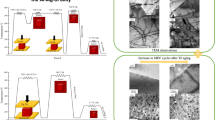Abstract
Loading path changes affect forming processes markedly. This matter is getting more important especially in metal forming process in which engineers face unexpected results after drawing processes. As a result, understanding of formability changes through strain-path changes is highly demanding. This paper investigates the effect of strain path change on the forming limit diagram (FLD) of 5083 aluminium alloy sheet experimentally and theoretically. The experimental method is a new approach for determining the FLD under nonproportional loadings. The aim is to understand the formability of this alloy under various strain paths. For this purpose, out-of-plane formability test method with a hemispherical punch was used. Considering trim operation during forming process will simulate the changes in loading. Furthermore, forming limit diagram was determined theoretically by using the well-known Marciniak and Kuczynski (M-K) method. The results showed that uniaxial prestraining increases and shifts the FLD to the left-hand side of the diagram for both parallel and perpendicular to the rolling direction. Biaxial prestraining shifts the FLD to the right-hand side of the diagram for both directions and also decreases the forming limit curve (FLC) for the specimens parallel to the rolling direction. Theoretical results showed good agreements with experimental observations.
Similar content being viewed by others
References
Graf A, Hosford W (1993) Effect of changing stain path on forming limit diagram of Al 2008-T4. Metall Trans B 24:65–75
Graf A, Hosford W (1994) The influence of strain path changes on forming limit diagram. Int J Mech Sci 36:897–910
Dariani B (1999) Effect of non proportional loading path on forming limit of sheet metals, Ph.D. Thesis. Amirkabir University of Technology, Tehran
Kuwabara T, Kuroda M, Tvergaard V, Nomura K (2000) Use of abrupt strain path change for determining subsequent yield surface: experimental study with metal sheets. Acta Mater 48:2071–2079
Kuroda M, Tvergaard V (2000) Effect of strain path change on limits to ductility of anisotropic metal sheets. Int J Mech Sci 42:867–887
Reyes, A., Hopperstad, O.S. (2009) Forming limit diagrams with an FE-based approach for sheets under non-proportional loading, 7th European LS-DYNA conference.
Stoughton TB (2000) A general forming limit criterion for sheet metal forming. Int J Mech Sci 42(1):1–27
Panich S, Uthaisangsuk V, Juntaratin J (2011) Determination of forming limit stress diagram for formability prediction of SPCE 270 steel sheet. Met Mater Process 21(1):19–27
Ozturk F, Lee D (2005) Experimental and numerical analysis of out-of-plane formability test. J Mater Process Technol 170(1–2):247–253
Hill R (1979) Theoretical plasticity of textured aggregates. Math Proc Camb Philos Soc 85:179–191
Marciniak Z, Kuczynski K (1967) Limit strains in the process of stretch-forming sheet metal. Int J Mech Sci 9:609–620
Assempour A, Hashemi R, Abrinia K, Ganjiani M, Masoumi E (2009) A methodology for prediction of forming limit stress diagrams considering the strain path effect. Comput Mater Sci 45(2):195–204
Hashemi R (2014) Analysis of necking in tube hydroforming by means of extended forming limit stress diagram. Engineering Solid Mechanics 2:73–82
Green DE, Angara TS, MortezaNurcheshmeh TW (2012) A practical method to evaluate the forming severity of tubular hydroformed parts. Int J Adv Manuf Technol 62(9–12):965–980
Hashemi R, Assempour A, Masoumi E (2009) Implementation of the forming limit stress diagram to obtain suitable load path in tube hydroforming. Journal of Materials and Design 30(9):3545–3553
Hashemi R, Faraji G, Abrinia K, Dezaji FA (2010) Application of the hydroforming strain- and stress-limit diagrams to predict necking in metal bellows forming process. Int J Adv Manuf Technol 46(5–8):551–561
Faraji GH, Hashemi R, Mashhadi MM, Dezaji FA (2010) Hydroforming Limits in metal bellows forming process. Mater Manuf Process 25(12):1413–1417
Kim J, Kim S-W, Park H-J, Kang B-S (2006) A prediction of bursting failure in tube hydroforming process based on plastic instability. Int J Adv Manuf Technol 27(5/6):518
Butuc MC, Gracio JJ, Barata da Rocha A (2003) A theoretical study on forming limit diagrams prediction. J Mater Process Technol 142(3):714–724
Hashemi R, Abrinia K, Assempour A (2013) The strain gradient approach to predict necking in tube hydroforming. J Manuf Process 15(1):51–55
Nurcheshmeh M., Green D.E., Investigation on the strain-path dependency of stress-based forming limit curves, International Journal of Material Forming, 4(1): 25–37.
Author information
Authors and Affiliations
Corresponding author
Appendix
Appendix
1.1 The geometric dimension of uniaxial tension part
The part that was used as the primary part for uniaxial tension prestrain step is shown below. (All dimensions are in millimetres.)

Rights and permissions
About this article
Cite this article
Zhalehfar, F., Hashemi, R. & Hosseinipour, S.J. Experimental and theoretical investigation of strain path change effect on forming limit diagram of AA5083. Int J Adv Manuf Technol 76, 1343–1352 (2015). https://doi.org/10.1007/s00170-014-6340-3
Received:
Accepted:
Published:
Issue Date:
DOI: https://doi.org/10.1007/s00170-014-6340-3




